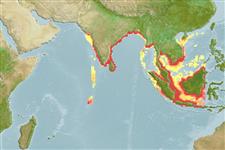分类 / Names
俗名 | 同种异名 | Catalog of Fishes(属, 种) | ITIS | CoL | WoRMS | Cloffa
Teleostei >
Clupeiformes (Herrings)
鯡目 (Herrings) >
Engraulidae (Anchovies)
鯷科 (Anchovies) > Coiliinae
Etymology: Coilia: Greek, koilia, -as = abdomen, hollow (Ref. 45335).
Eponymy: Jean-Jacques Dussumier (1792–1883) was a French merchant, collector, traveller and ship owner. [...] (Ref. 128868), visit book page.
More on author: Valenciennes.
Environment: milieu / climate zone / depth range / distribution range
生态学
海洋; 淡水; 半咸淡水; 非产卵性溯降河的 (Ref. 51243); 深度上下限 0 - 50 m (Ref. 189). 熱帶; 24°N - 9°S, 70°E - 118°E (Ref. 189)
Indian Ocean: India from Bombay to Calcutta, probably also Myanmar, Thailand and Malaysia. Western Central Pacific: Thailand to Java, presumably also Kalimantan). Valenciennes listed a specimen from Mahé which lies to the south of Cannanore, India but there is no such specimen in Paris.
印度洋: 從孟買到加爾各答的印度, 可能也緬甸,泰國與馬來西亞。 中西太平洋: 泰國到爪哇, 可能也加里曼丹). Valenciennes 列出了來自位於印度的坎納諾爾南方的 Mahe 的一件標本,但是在巴黎沒有如此的標本。
Length at first maturity / 大小 / 重量 / 年龄
Maturity: Lm ?, range 1 - ? cm
Max length : 20.0 cm SL 雄鱼/尚未辨别雌雄; (Ref. 9822); common length : 17.0 cm TL 雄鱼/尚未辨别雌雄; (Ref. 9822)
背棘 (总数) : 0; 臀棘: 0; 臀鳍软条: 80. Body tapering, belly rounded before pelvic fins, with 5 or 6 (rarely 4) + 7 to 9 = 12 to 15 keeled scutes from just behind pectoral fin base to anus. Maxilla short. Pectoral fin with 6 long filaments and 9 to 11 (rarely 8) branched fin rays. Flanks and belly with golden or pearly spots (light organs) in rows below scales, also along isthmus, edge of lower jaw, on cheek and gill cover.
身体尖端细的, 腹面圆形的以前腹鳍有 5 或 6(很少地 4)+7 到 9=12 到 15个从在胸鳍基底正后方到肛门的有龙骨的鳞甲。 颚骨短。 胸鳍有 6个长的丝状突起与 9 到 11(很少地 8)个分枝的鳍条。 侧面而且在鳞片之下在列中腹面有金或者浅蓝灰色斑点 (发光器), 也沿着峡部,下颌的边缘, 在颊与鳃盖上。
A coastal and estuarine species, occurring in fully saline water, but also able to tolerate lowered salinities, perhaps almost fresh water. Feeds on copepods, prawn and fish larvae, various unidentified crustaceans and cypris, also stomatopod larvae, mysids, polychaete larvae, isopods and Sagitta. The breeding season is perhaps extended; probably entering estuaries to breed (larvae about 5 km up Burhabalang estuary, Orissa, India in May and June). Utilized as a food fish (Ref. 171).
被出现在纯海水的一个海岸而河口的种, 也能容忍低盐度, 也许几乎淡水。 吃桡脚类的动物,虾与仔鱼,各种不同的未确认的甲壳动物与鲤科鱼类, 也口足目幼生,糠虾, 多毛类的仔鱼,等足目动物与 矢耳石 . 繁殖季节也许被延伸; 可能进入河口到繁殖。 (仔鱼大约 5个公里上游 Burhabalang 河口,奥里萨 , 印度在五月与六月) 作为食用鱼.(参考文献 171)
Life cycle and mating behavior
成熟度 | 繁殖 | 产卵场 | 卵 | 孕卵数 | 仔鱼
Breeding season is perhaps extended. Spawn in school (Ref. 205).印度洋: 從孟買到加爾各答的印度, 可能也緬甸,泰國與馬來西亞。 中西太平洋: 泰國到爪哇, 可能也加里曼丹). Valenciennes 列出了來自位於印度的坎納諾爾南方的 Mahe 的一件標本,但是在巴黎沒有如此的標本。
Wongratana, T., T.A. Munroe and M. Nizinski, 1999. Order Clupeiformes. Engraulidae. Anchovies. p. 1698-1753. In K.E. Carpenter and V.H. Niem (eds.) FAO species identification guide for fishery purposes. The living marine resources of the WCP. Vol. 3. Batoid fishes, chimaeras and bony fishes part 1 (Elopidae to Linophrynidae). FAO, Rome. (Ref. 9822)
世界自然保护联盟红皮书 (Ref. 130435: Version 2024-2)
人类利用
渔业: 商业性
工具
特别资料
下载 XML
网络资源
Estimates based on models
Preferred temperature (Ref.
123201): 27.6 - 29.3, mean 28.7 °C (based on 640 cells).
Phylogenetic diversity index (Ref.
82804): PD
50 = 0.5001 [Uniqueness, from 0.5 = low to 2.0 = high].
Bayesian length-weight: a=0.00355 (0.00193 - 0.00653), b=3.01 (2.85 - 3.17), in cm total length, based on LWR estimates for this species & Genus-body shape (Ref.
93245).
营养阶层 (Ref.
69278): 3.3 ±0.39 se; based on food items.
Generation time: 0.9 (0.8 - 1.0) years. Estimated as median ln(3)/K based on 12
growth studies.
回复力 (Ref.
120179): 高度, 族群倍增时间少于 15个月 (tm=0.5-0.6; K=1.07-1.54; Fec=1,000-5,000).
Fishing Vulnerability (Ref.
59153): Low vulnerability (14 of 100).
Nutrients (Ref.
124155): Calcium = 398 [117, 1,022] mg/100g; Iron = 2.56 [0.78, 7.00] mg/100g; Protein = 17.3 [14.5, 20.2] %; Omega3 = 0.306 [0.155, 0.612] g/100g; Selenium = 50.5 [22.8, 113.4] μg/100g; VitaminA = 18.1 [5.4, 46.9] μg/100g; Zinc = 1.62 [0.78, 3.23] mg/100g (wet weight); based on
nutrient studies.
